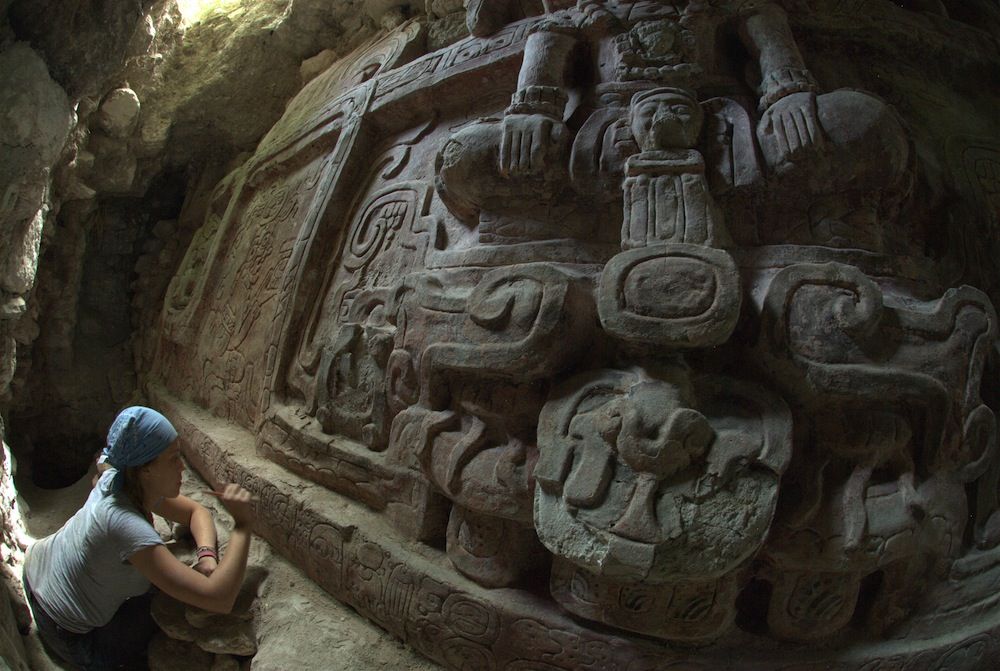Amazing Maya Facade Exposed in Guatemala

An enormous and elaborately decorated Maya façade has been uncovered in Guatemala on the outside of an ancient building that archaeologists are trying to explore.
Grave robbers came close to finding the 26-foot-long (8 meters) and 6.5-foot-high (2 m) stucco relief before archaeologists got there. The 1,400-year-old carvings were discovered last month as excavators dug up a tunnel left open by looters at the site of Holmul — an ancient Maya city in the Peten region of Guatemala.
The frieze decorates the outside of a huge multi-roomed rectangular building where a team of archaeologists led by Francisco Estrada-Belli, who teaches at Tulane University, found a burial last year containing the remains of one person, 28 ceramic vessels and a wooden funerary mask. Much of the building is still buried under the rubble of another 65-foot-high (20 m) structure that was later constructed on top of it. So far, only the roof, one corner and part of the stairway have been uncovered in recent excavations. [See Photos of the Newfound Maya Frieze]
Bigger Maya buildings can be found at other sites like Copan and Xultun, but the structure at Holmul stands out for its preservation, the complexity of the iconography and the abundance of inscriptions, Alex Tokovinine, a Maya epigrapher at Harvard who is working on the project at Holmul, explained in an email.

The well-preserved frieze has rare traces of polychrome red paint, with some details in blue, green and yellow. The carving also shows human figures, perhaps deified rulers, some of them wearing elaborate bird headdresses and jade jewelry."It features two previously unknown gods and at least five previously unknown rulers or deified ancestors," Tokovinine wrote. "And who knows what the rest of the building holds?
The inscriptions, meanwhile, reveal that the monumental artwork was commissioned by the ruler of Naranjo, a powerful kingdom to the south of Holmul, likely during the 590s, the researchers say. A king named "Ajwosaj Chan K’inich — one of the greatest Naranjo rulers — is credited in the text with restoring the local ruling line and patron deities, the researchers say.
"The new inscription provides the first glimpse of the remarkable extent of Ajwosaj’s political and religious authority," Tokovinine said in a statement. "It also reveals how a new order was literally imprinted on a broader landscape of local gods and ancestors."
Sign up for the Live Science daily newsletter now
Get the world’s most fascinating discoveries delivered straight to your inbox.
The team plans to return to the site next year to continue exploring the building and to preserve the fragile façade.
"The site is constantly guarded, but the main enemies there are the rainy season and tree roots," Tokovinine told LiveScience.
Changes in temperature and humidity also threaten to damage the paint of the façade, and tree roots growing between the stucco of the frieze and the stone masonry of the roof could damage the carving, Tokovinine said. If nothing is done, he added, "It will just fall off the walls in hundreds of small fragments."
"Unfortunately, there was no time for any extensive conservation intervention nor for a detailed digital 3D scanning of the frieze," he added. "Hopefully, it will all get done next dry season or even sooner."
The research was in part supported by the National Geographic Society/Waitt Grants Program.
Follow Megan Gannon on Twitter and Google+. Follow us @livescience, Facebook & Google+. Original article on LiveScience.com











